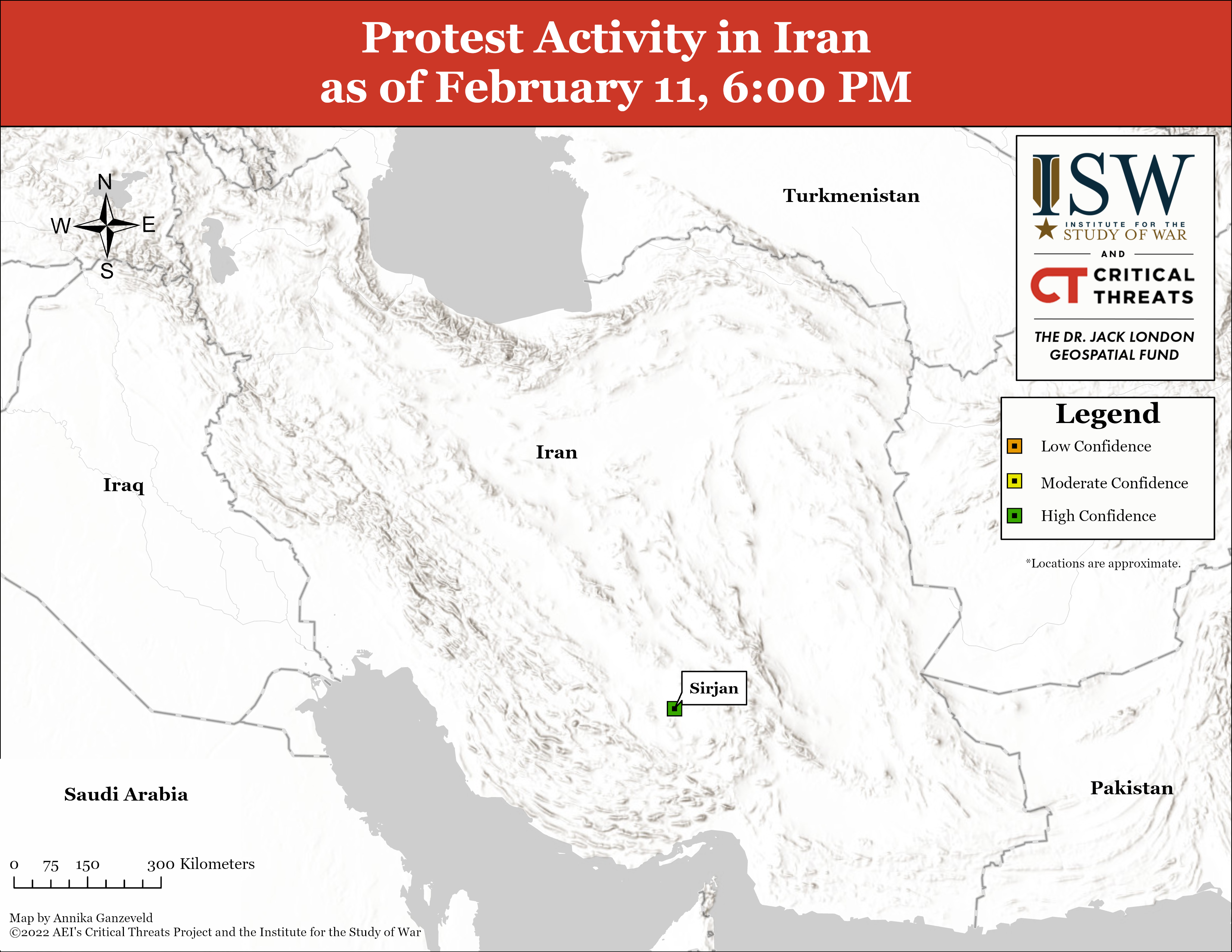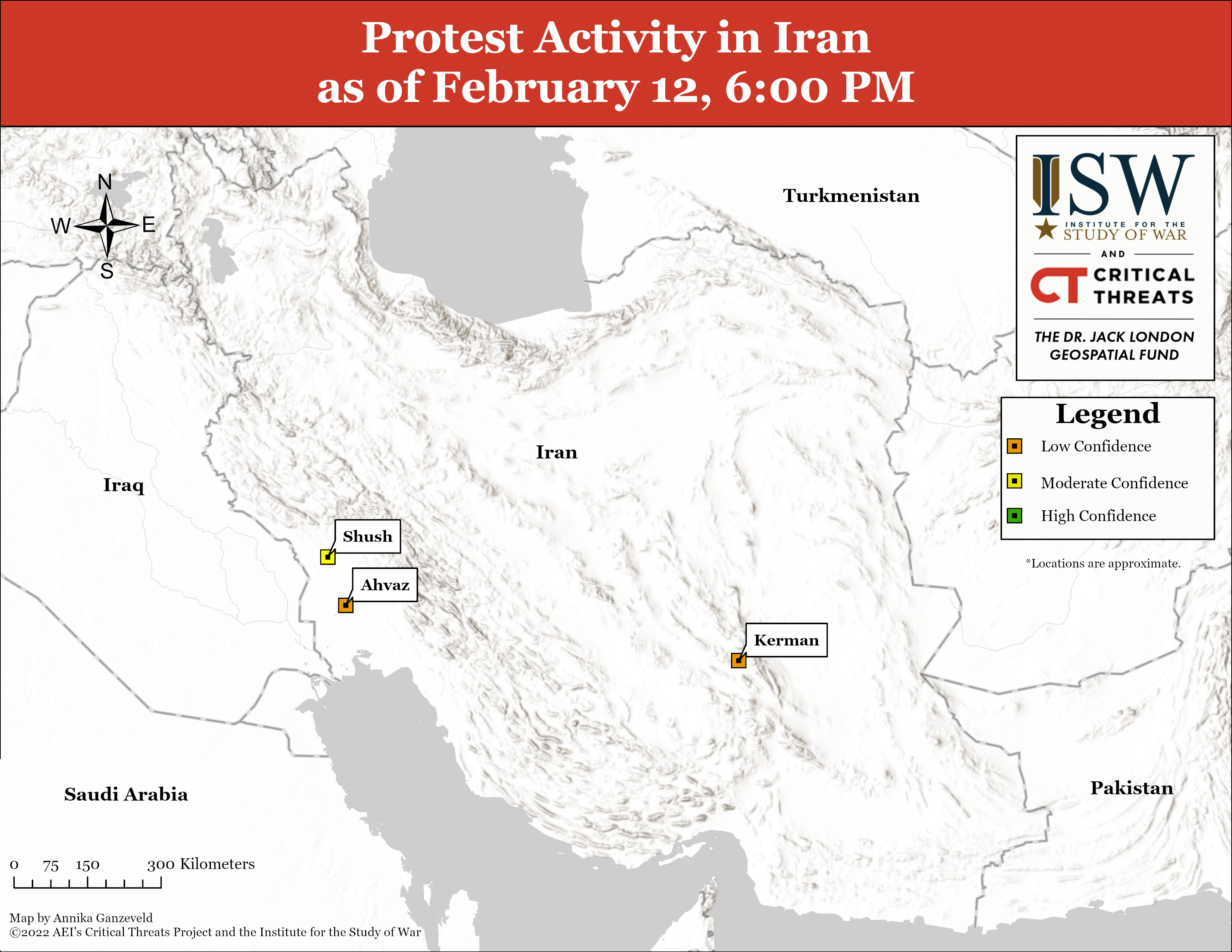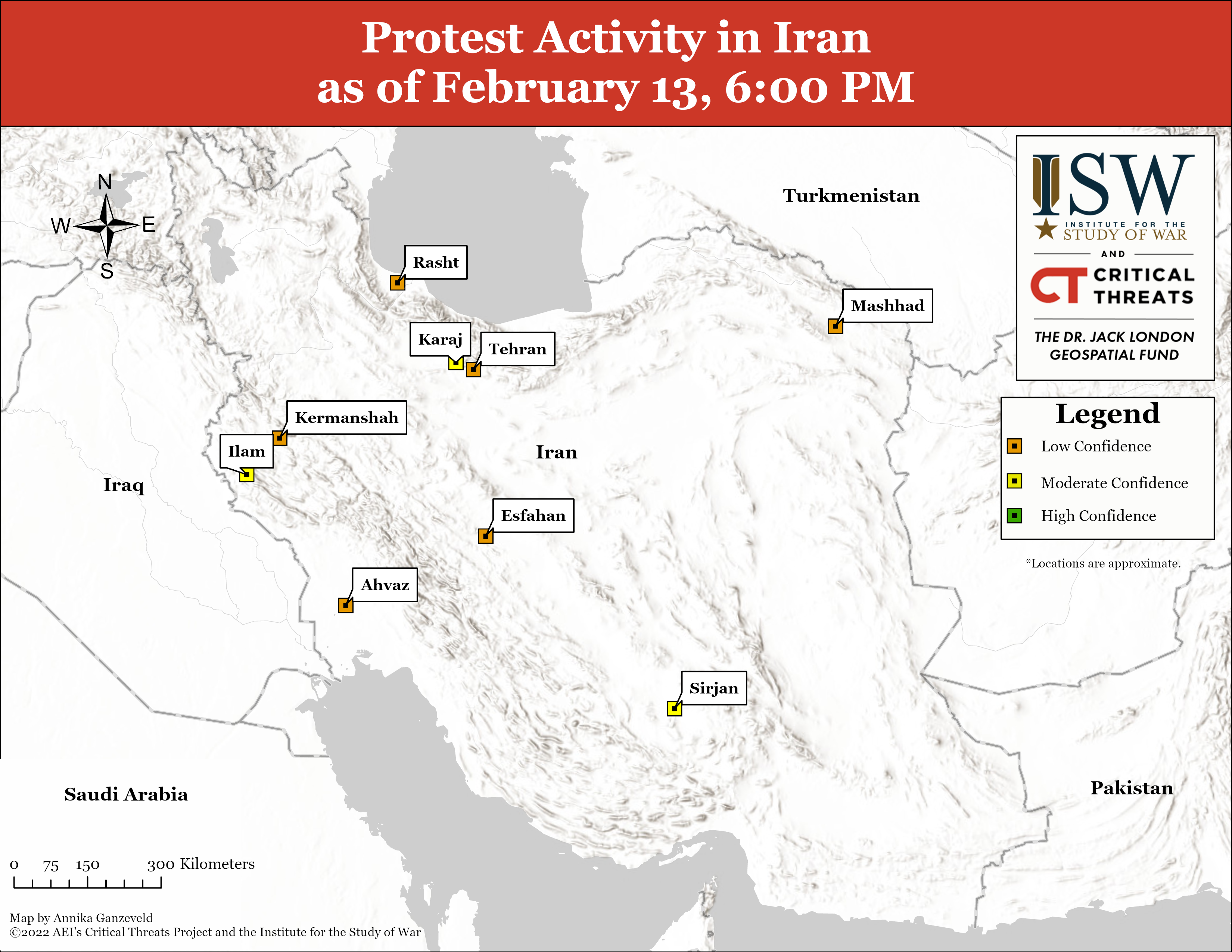{{currentView.title}}
February 13, 2023
Iran Update, February 13, 2023
February 13, 2023, 6:00 pm ET
The Iran Updates are produced by the Critical Threats Project (CTP) at the American Enterprise Institute with support from the Institute for the Study of War (ISW). To receive Iran Updates via email, please subscribe here.
The IRGC Quds Force is likely coordinating a large-scale effort to consolidate its control and influence over critical transportation routes and nodes through Syria. Kataib Hezbollah (KH)—an Iranian-backed Iraqi militia—assumed control of a key logistics chokepoint on the Iraqi side of the al Qaim border crossing on February 11 likely to facilitate Iranian weapons shipments into Syria.[i] A Syrian Twitter account reported that KH has begun expediting the transfer of such shipments across the border, likely to mitigate the possibility of an Israeli airstrike interdicting and destroying them. The Quds Force and Iranian-backed militias have expanded their presence on the Syrian side of the border in recent years.[ii] Iranian control over both sides of the crossing has consolidated Iranian control of an important node on the ground line of communication that connects Iran to western Syria and Lebanon. CTP previously assessed that the Quds Force is exploiting the recent earthquake in Syria and Turkey to justify these changes in border personnel.[iii]
The Quds Force is similarly attempting to expand its presence over an important transportation corridor that runs from Damascus to northern Syria. Quds Force Commander Brigadier General Esmail Ghaani traveled to Aleppo Province on February 8 and likely met with the commander of Russian forces in Syria, Colonel General Andrey Serdyukov, as CTP previously reported.[iv] He later traveled to Latakia Province and met with its governor, Amer Ismail Hilal, on February 12.[v] Lebanese Hezbollah (LH) officials likely accompanied Ghaani during his time in Aleppo based on available imagery, shortly before LH sent a 23-truck humanitarian aid convoy to northern Syria on February 12.[vi] Ghaani may have coordinated with Serdyukov and Hilal on the Quds Force expanding control over critical transportation routes connecting northern Syria to central Syria along the M4 and M5 highways.
Iran has long sought to consolidate control of these key transportation nodes to deepen its control and influence in Syria. Iran has secured positions along major land routes throughout the country and heavily participated in the battle to retake Aleppo from the Syrian opposition in 2016.[vii] Northern Syria—especially Aleppo—is a location of significance to most major actors in Syria, including Russian forces, the Assad regime, Syrian Democratic Forces, Hayat Tahrir al Sham, and Turkey and its affiliated Syrian militias. Expanding Iranian influence in northern Syria could grant Tehran greater leverage over the Assad regime by increasing Iranian control over one of the most important economic hubs and transit corridors in Syria. Expanding Iranian influence could also facilitate military cooperation with Russia. Moscow controls the Hmeimim airport in nearby Latakia Province and uses it for various military operations and possibly arms transfers. Tehran, finally, likely seeks to expand its military presence in northern Syria to improve its defensive posture to deter or if necessary resist a Turkish ground incursion nearby.
The Quds Force is using humanitarian aid as cover for its efforts to expand its presence in key areas likely to obstruct Israeli efforts to interdict and destroy Iranian weapons shipments into and around Syria. Expanding Iranian control over multiple supply routes into and through Syria, such as the al Qaim border crossing, Aleppo airport, and Latakia port, will likely complicate Israeli efforts to identify and strike weapons shipments. Increasing the number and types of possible means of transportation and the number of potential targets—officially claimed to be humanitarian aid convoys by Iran—can impede Israeli target selection.
Iranian leaders and state-run media promoted the narrative that the regime has popular support surrounding the anniversary of the founding of the Islamic Republic on February 11. Iranian officials organized pro-regime rallies throughout Iran and issued statements celebrating them on February 11. Some officials claimed that turnout was significantly greater than in previous years, although images and videos of the rallies do not suggest a significant difference if any at all.[viii] Regime officials separately focused heavily on the amnesty and commutation of sentences that Supreme Leader Ali Khamenei granted arrested protesters on February 6.[ix] Officials and state-run media framed the amnesty as a step toward reinforcing popular support for the regime.[x]
President Ebrahim Raisi announced on February 13 that he obtained permission from Khamenei to extend the amnesty and commutation of sentences to university students and celebrities.[xi] It is not clear that these groups were previously excluded from Khamenei’s decree or that Raisi’s statement represents any meaningful change in the policy that Khamenei had already announced. Raisi may have made the statement to positively frame himself to the public as being involved in the amnesty and commutation of sentences and able to secure boons from the supreme leader on behalf of the people.
Some Iranian officials focused on discussing economic grievances rather than publicly continuing the conversation they have had in recent days about the growing alienation of the population. Parliament Speaker Mohammad Bagher Ghalibaf, who has previously called for limited economic and sociopolitical reforms, discussed economic frustrations with parliamentarians on February 11.[xii] Raisi stated that his administration is actively working to solve the country’s economic problems during a pro-regime rally in Tehran February 11.[xiii] The IRGC separately published a statement on February 11 in which it wrote that the regime must make effective and serious plans to alleviate economic and livelihood difficulties.[xiv] These regime officials are correctly acknowledging protesters’ economic frustrations but ignoring at least publicly the other issues driving discontent, such as the social oppression of women, human rights abuses, and expanding censorship.
The regime meanwhile continued to crack down aggressively on violations of the mandatory hijab law, further highlighting the regime’s eagerness to return to what it perceives to be normalcy. Raisi stated on February 12 that cultural and media organizations must “persuasively explain” the importance of hijab to the public.[xv] Iranian media separately reported on February 13 than an LEC officer received “educational vindication” after failing to confront an unveiled women in Kermanshah Province.[xvi]
Former President Hassan Rouhani acknowledged on February 11 that the Islamic Republic has not returned to a normal state of affairs despite hardliner officials’ efforts to return to business as relatively usual. Rouhani emphasized that the Islamic Revolution belongs to “the people” and that the revolution will end if a “power-hungry minority” pushes the majority aside.[xvii] Rouhani’s statement is noteworthy in that he has continued to call for broader change to the regime rather than discussing economic issues as Raisi and Ghalibaf did.
Key Takeaways
- The IRGC Quds Force is likely coordinating a large-scale effort to consolidate its control and influence over critical transportation routes and nodes through Syria. Iran has long sought to consolidate control of these key transportation nodes to deepen its control and influence in Syria.
- Iranian leaders and state-run media promoted the narrative that the regime has popular support surrounding the anniversary of the founding of the Islamic Republic.
- Some Iranian officials focused on discussing economic grievances rather than publicly continuing the conversation they have had in recent days about the growing alienation of the population.
- CTP recorded one protest on February 11, three protests on February 12, and ten protests on February 13.
- Over 300 Iranian activists, journalists, and reformist politicians signed an open letter expressing support for Mir Hossein Mousavi and his calls for “foundational” change in Iran.
- Amwaj Media—a UK-based, anti-regime site—reported on February 12 that Iranian officials have renewed internal discussions over whether to establish a parliamentary system, citing an unidentified hardline source.
- President Ebrahim Raisi is conducting an official visit to China from February 13 to 16.
Internal Security and Protest Activity
At least one protest occurred in one city across one province on February 11. CTP assesses with high confidence that one protest occurred in the following location:
Sirjan, Kerman Province[xviii]
- Size: Small
- Demographic: Copper miners on strike

At least three protests occurred in three cities across two provinces on February 12. CTP assesses with moderate confidence that one protest occurred in the following location:
Shush, Khuzestan Province[xix]
- Size: Small
- Demographic: Retirees
CTP assesses with low confidence that protests occurred in the following locations:
Kerman, Kerman Province[xx]
- Size: Small
- Demographic: Retirees
Ahvaz, Khuzestan Province[xxi]
- Size: Small
- Demographic: Retirees

At least ten protests occurred in nine cities across nine provinces on February 13. CTP assesses with moderate confidence that protests occurred in the following locations:
Karaj, Alborz Province[xxii]
- Size: Small
- Demographic: Families of prisoners sentenced to death
- Notes: It is unclear whether these prisoners are related to the Mahsa Amini protest movement.
Ilam, Ilam Province[xxiii]
- Size: Small
- Demographic: Retired telecommunications workers
Sirjan, Khuzestan Province[xxiv]
- Size: Small
- Demographic: Copper miners on strike
CTP assesses with low confidence that protests occurred in the following locations:
Esfahan City, Esfahan Province[xxv]
- Size: Small
- Demographic: Retired telecommunications workers
Rasht, Gilan Province[xxvi]
- Size: Small
- Demographic: Retired telecommunications workers
Kermanshah, Kermanshah Province[xxvii]
- Size: Small
- Demographic: Retired telecommunications workers
Ahvaz, Khuzestan Province[xxviii]
- Size: Small
- Demographic: Retired telecommunications workers
Mashhad, Khorasan Razavi Province[xxix]
- Size: Small
- Demographic: Retired telecommunications workers
Tehran City, Tehran Province[xxx]
- Size: Small
- Demographic: Contract workers for an oil company
Tehran City, Tehran Province[xxxi]
- Size: Small
- Demographic: Retired telecommunications workers

Protest coordinators and organizations called for demonstrations on the following date:
February 16:[xxxii]
- Type: Demonstrations, and 40-day commemoration ceremony of executed protesters in Tehran
- Location: Countrywide
Over 300 Iranian activists, journalists, and reformist politicians signed an open letter expressing support for Mir Hossein Mousavi and his calls for “foundational” change in Iran.[xxxiii] Mousavi published a statement on February 4, in which he adopted a revolutionary (or counter-revolutionary in the context of the Islamic Republic) tone, calling for a referendum on whether to maintain the Islamic Republic and for drafting a new constitution if that referendum fails.[xxxiv]
Amwaj Media—a UK-based, anti-regime site—reported on February 12 that Iranian officials have renewed internal discussions over whether to establish a parliamentary system, citing an unidentified hardline source.[xxxv] The source claimed that senior officials have considered trying to implement such reform in the coming months but have not finalized any decision, suggesting that Supreme Leader Ali Khamenei has not yet approved or rejected this possibility. This internal regime discussion is not new; Iranian officials have discussed this possible reform for years. But they may have renewed this discussion in response to the Mahsa Amini protests.
The regime would need to reform the constitution to establish a parliamentary system. The constitution enshrines the president as the most senior Iranian official below the supreme leader and has no provision for a prime minister.[xxxvi] The regime amended the constitution in 1989 to abolish the position of prime minister. The supreme leader is responsible for proposing and approving constitutional changes, which then go to a national referendum for final ratification.
Agricultural Jihad Minister Javad Sadati Nejad announced on February 12 that President Ebrahim Raisi ordered grocery store chains to issue 10-to-25-percent discounts for 32 basic goods for the next three months.[xxxvii] These goods include common grocery items, such as beans, rice, and meats. The grocery stores will forgo profiting from the sale of these items, according to Sadati Nejad. The Raisi administration likely seeks to shift the economic burden of inflation onto large companies, some of which may be parastatal entities, to alleviate pressure on ordinary citizens.
Prominent Sunni cleric Moulana Abdol Hamid criticized unspecified universities in a tweet in response to reports that they fired and suspended professors for political reasons.[xxxviii] Abdol Hamid described the dismissal and suspension of professors as an attack on the scientific foundations of the country.
IRGC-affiliated Fars News Agency published articles on February 13 trying to counter Abdol Hamid’s repeated criticisms of the regime and discredit him among the public. Fars News Agency published an article celebrating how the regime has empowered Iranian Sunnis since the revolution.[xxxix] The outlet published a second article associating Abdol Hamid with the Afghan Taliban.[xl] Tehran does not recognize the Taliban as a terrorist organization and has sought to cooperate with them since the fall of Kabul in 2021. Fars News Agency nevertheless intends to frame Abdol Hamid negatively to the Iranian public by portraying him as a Taliban associate and supporter.
An unidentified individual killed an LEC officer around Khoy, West Azerbaijan Province on February 13.[xli] Iranian state media reported that the LEC officer deployed from Oroumiyeh to Khoy to support earthquake-relief efforts and promote security. Iranian state media also described the perpetrator as robber whom the LEC officer tried to arrest.
An unidentified individual stabbed a cleric and fled on a motorcycle in Tehran on February 13.[xlii] The cleric was hospitalized after the attack. Attacks against clerics have become increasingly frequent throughout Iran in recent months. Unidentified individuals stabbed and wounded four clerics in Qom on December 18, as CTP previously reported.[xliii]
Foreign Affairs and Diplomacy
President Ebrahim Raisi is conducting an official visit to China from February 13 to 16.[xliv] Raisi stated that he will discuss economic and energy cooperation and sign 20 agreements during the visit.[xlv] Raisi called for expanding strategic cooperation with China in an op-ed in the People’s Daily before leaving Tehran on February 13.[xlvi] The People’s Daily is the official newspaper of the Central Committee of the Chinese Communist Party. Raisi also met with and reported to Khamenei on his plans for the visit before leaving Tehran.[xlvii] The following Iranian officials are accompanying Raisi to China: Foreign Affairs Minister Hossein Amir Abdollahian; Economic Affairs and Finance Minister Ehsan Khandouzi; Roads and Urban Development Minister Mehrdad Bazarpash; Oil Minister Javad Owji; Agricultural Jihad Minister Javad Sadati Nejad; Industry, Mining, and Trade Minister Reza Fatemi Amin; Central Bank Governor Mohammad Reza Farzin; and Presidential Chief of Staff Gholam Hossein Esmaeili.
[i] https://twitter.com/Mzahem_Alsaloum/status/1624352945696276482
[ii] https://www.washingtoninstitute.org/policy-analysis/how-iranian-militias-have-swallowed-deir-ezzor
[iii] https://www.criticalthreats.org/analysis/iran-update-february-10-2023
[iv] https://www.criticalthreats.org/analysis/iran-update-february-10-2023
[v] https://twitter.com/IranDailyWeb/status/1624733554805547011
[vi] https://twitter.com/IntelliTimes/status/1624490431105978368?s=20&t=V-Wmki00RlpvCh0Ed1iwhg
[vii] https://www.aei.org/foreign-and-defense-policy/middle-east/irans-evolving-way-of-war-how-the-irgc-fights-in-syria/
[viii] http://www.defapress dot ir/fa/news/573017
[ix] http://www.president dot ir/fa/142364
[x] http://www.nournews dot ir/fa/news/129984
[xi] http://www.president dot ir/fa/142364
[xii] https://www.tasnimnews dot com/fa/news/1401/11/23/2852249
[xiii] http://www.president dot ir/fa/142362
[xiv] http://www.tasnimnews dot com/fa/news/1401/11/23/2852431
[xv] http://www.president dot ir/fa/142377
[xvi] https://www.isna dot ir/news/1401112318020
[xvii] https://www.entekhab dot ir/fa/news/714539
[xviii] https://twitter.com/iranworkers/status/1624349828208640003?cxt=HHwWhoC-1YDk7IotAAAA;
[xix] https://twitter.com/iranworkers/status/1624745180858314752?cxt=HHwWgMCzucfIoIwtAAAA;
[xx] https://twitter.com/iranworkers/status/1624767873750114304?cxt=HHwWgIC91brxqowtAAAA;
[xxi] https://twitter.com/iranworkers/status/1624694921524396034?cxt=HHwWhIC-nYrbiYwtAAAA;
[xxii] https://twitter.com/hra_news/status/1625158441017671686?cxt=HHwWjICwybu_3I0tAAAA;
[xxiii] https://twitter.com/hra_news/status/1625159951604645888?cxt=HHwWgICwqbKX3Y0tAAAA;
[xxiv] https://twitter.com/iranworkers/status/1625046730747043840?cxt=HHwWgICzmYnZqY0tAAAA;
[xxv] https://twitter.com/iranworkers/status/1625061000226516993?cxt=HHwWgsC9jdWXsI0tAAAA;
[xxvi] https://twitter.com/iranworkers/status/1625186912762839041?cxt=HHwWgoC-zd646Y0tAAAA
[xxvii] https://twitter.com/iranworkers/status/1625060383475073025?cxt=HHwWgoC8-eHzr40tAAAA;
[xxviii] https://twitter.com/iranworkers/status/1625060176372854790?cxt=HHwWjMCz9drnr40tAAAA;
[xxix] https://twitter.com/iranworkers/status/1625077389150633984?cxt=HHwWgIC-jdDRt40tAAAA
[xxx] https://twitter.com/iranworkers/status/1625056721470214144?cxt=HHwWgMC-8c2ero0tAAAA;
[xxxi] https://twitter.com/iranworkers/status/1625097491459833856?cxt=HHwWgIC8_d3jwI0tAAAA;
[xxxii] https://twitter.com/UYI_fa/status/1622544042734104576?s=20&t=Ex4C157bDrs_LMl5ofDOxg;
[xxxiii] https://www.radiofarda.com/a/iran-s-political-media-activists-supports-referendum-idea/32267734.html
[xxxiv] https://www.criticalthreats.org/analysis/iran-update-february-6-2023
[xxxv] https://amwaj dot media/article/is-rouhani-plotting-a-comeback-on-iran-s-political-stage
[xxxvi] https://www.refworld.org/docid/3ae6b56710.html
[xxxvii] http://www.tasnimnews dot com/fa/news/1401/11/23/2852173
[xxxviii] https://twitter.com/AbdolhamidNet/status/1625059230544805888; https://www.entekhab dot ir/fa/news/714817; https://www.entekhab dot ir/fa/news/714658
[xxxix] https://www.farsnews dot ir/news/14011124000905
[xl] https://www.farsnews dot ir/news/14011112000770
[xli] www.defapress dot ir/fa/news/573328
[xlii] https://www.entekhab dot ir/fa/news/714860
[xliii] https://www.criticalthreats.org/analysis/iran-crisis-update-december-18
[xliv] www.president dot ir/fa/142409
[xlv] www.president dot ir/fa/142411
[xlvi] http://cpc.people dot com.cn/n1/2023/0213/c64387-32622338.html
[xlvii] www.leader dot ir/fa/content/26313
